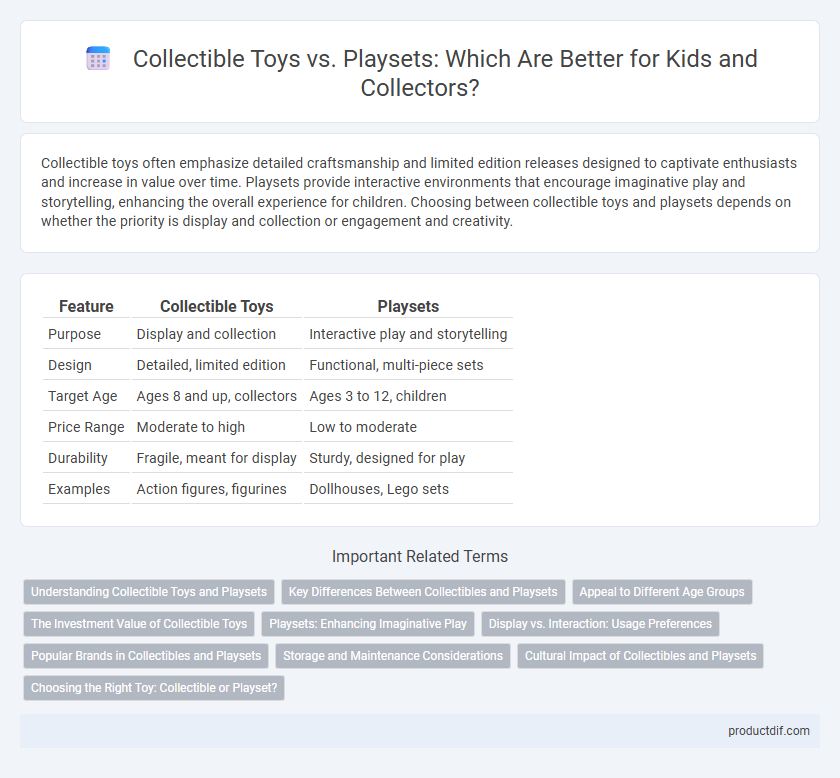Collectible toys often emphasize detailed craftsmanship and limited edition releases designed to captivate enthusiasts and increase in value over time. Playsets provide interactive environments that encourage imaginative play and storytelling, enhancing the overall experience for children. Choosing between collectible toys and playsets depends on whether the priority is display and collection or engagement and creativity.
Table of Comparison
| Feature | Collectible Toys | Playsets |
|---|---|---|
| Purpose | Display and collection | Interactive play and storytelling |
| Design | Detailed, limited edition | Functional, multi-piece sets |
| Target Age | Ages 8 and up, collectors | Ages 3 to 12, children |
| Price Range | Moderate to high | Low to moderate |
| Durability | Fragile, meant for display | Sturdy, designed for play |
| Examples | Action figures, figurines | Dollhouses, Lego sets |
Understanding Collectible Toys and Playsets
Collectible toys are designed primarily for display and value appreciation, often featuring limited editions, detailed craftsmanship, and character-based themes that appeal to enthusiasts and collectors. Playsets, on the other hand, offer interactive environments that encourage imaginative play, combining multiple figures, accessories, and themed landscapes to create immersive storytelling experiences. Understanding the distinction between collectible toys and playsets helps buyers choose items based on purpose--whether for display, investment, or active play.
Key Differences Between Collectibles and Playsets
Collectible toys primarily serve as display items valued for rarity, design, and brand affiliation, often appealing to adult collectors. Playsets emphasize interactive play, featuring multiple components and environments to foster imaginative scenarios for children. The key differences lie in their intended use, with collectibles prioritizing preservation and aesthetic appeal, while playsets focus on functionality and engagement.
Appeal to Different Age Groups
Collectible toys often attract older children and adult collectors due to their detailed craftsmanship and limited editions, enhancing their value and display appeal. Playsets are designed primarily for younger children, encouraging creativity and imaginative play through interactive environments and accessories. Both types cater to distinct developmental stages, with collectible toys focusing on preservation and aesthetics, while playsets emphasize hands-on engagement and storytelling.
The Investment Value of Collectible Toys
Collectible toys often appreciate in value over time due to rarity, brand association, and limited production runs, making them attractive investments compared to playsets, which typically have lower resale value. Iconic collectible toy lines like Funko Pop, Hot Wheels, and vintage action figures from franchises such as Star Wars or Marvel consistently show strong market demand in secondary markets. The investment potential of collectible toys depends on factors including condition, packaging integrity, and historical significance, which are less emphasized in playsets designed primarily for active play rather than long-term value retention.
Playsets: Enhancing Imaginative Play
Playsets offer immersive environments that boost imaginative play by providing detailed scenes and interactive elements, encouraging children to create complex stories and role-playing scenarios. Unlike collectible toys that focus on rarity and display, playsets engage multiple senses and promote social interaction by enabling shared storytelling experiences. These features make playsets invaluable for cognitive development and creativity enhancement in children's playtime.
Display vs. Interaction: Usage Preferences
Collectible toys are primarily valued for display due to their detailed craftsmanship and limited edition status, attracting enthusiasts who prioritize visual appeal and preservation. Playsets emphasize interactive play, offering immersive environments and multiple components that encourage imaginative storytelling and hands-on engagement. Consumer preferences often depend on whether they seek aesthetic collection or dynamic play experiences, shaping the demand in the toy market.
Popular Brands in Collectibles and Playsets
Popular collectible toy brands include Funko Pop, LEGO Minifigures, and Hot Wheels, offering limited-edition figures and intricately designed miniatures that attract avid collectors. Leading playset brands like LEGO, Playmobil, and Fisher-Price provide interactive environments for imaginative play, featuring themes such as cityscapes, fantasy worlds, and everyday life. Both categories emphasize craftsmanship and brand legacy, with collectibles focusing on rarity and display value, while playsets prioritize engagement and storyline development.
Storage and Maintenance Considerations
Collectible toys require specialized storage solutions such as display cases with dust protection to preserve their condition and value. Playsets often need more extensive maintenance, including regular cleaning of multiple components and ensuring all moving parts remain functional. Proper storage for playsets typically involves larger containers or shelves to organize pieces and prevent loss or damage.
Cultural Impact of Collectibles and Playsets
Collectible toys, such as action figures and limited-edition models, shape popular culture by fueling nostalgia and fostering communities of enthusiasts who celebrate iconic characters and franchises. Playsets provide immersive environments that encourage imaginative play and storytelling, often reflecting societal values and trends through their detailed designs. Both collectibles and playsets influence cultural identity by connecting generations and inspiring creativity across age groups.
Choosing the Right Toy: Collectible or Playset?
Choosing between collectible toys and playsets depends on the child's interests and developmental needs; collectible toys like action figures or limited-edition items appeal to collectors and encourage imaginative play through individual characters. Playsets, such as dollhouses or themed adventure kits, offer interactive environments that promote creativity and social interaction by enabling story-building and role-playing. Considering age-appropriateness, durability, and play value helps determine which option fosters engagement and enjoyment best.
Collectible Toys vs Playsets Infographic

 productdif.com
productdif.com